Iron tsuba of mokkō form decorated with inome (wild boar's eye) in openwork (sukashi) outlined with brass wire. The plate decorated with 3 concentric circular rows of brass dots in ten-zōgan. Center of the plate outlined with the inlaid circular brass wire (sen-zōgan). Some dots and the outline of inome on the face are missing.
Ōnin school. Unsigned. Mid Muromachi period, middle of the 15th century. Dimensions: 72.1 x 71.3 x 2.3 mm.-

-

Iron tsuba of round form with brown patina decorated with the design of a Buddhist temple bell (tsurigane) in openwork (sukashi), with details outlined in brass wire (sen-zōgan), the outer ring decorated with two rows of brass dots (ten-zōgan), and the bell details carved in sukidashi-bori as on kamakura-bori pieces.
Ōnin school. Unsigned. Late Muromachi period, 16th century. Dimensions: 88.8 x 88.3 x 3.0 mm. As per Merrily Baird, two legends are usually associated with the image of tsurigane, a large, suspended Buddhist bell: one is that of Dojo Temple (Dojo-ji), and the other is of Benkei stealing the tsurigane of Miidera Temple. Interestingly, this type of bell (tsurigane) is not described as a family crest (mon), while suzu and hansho bells are. -
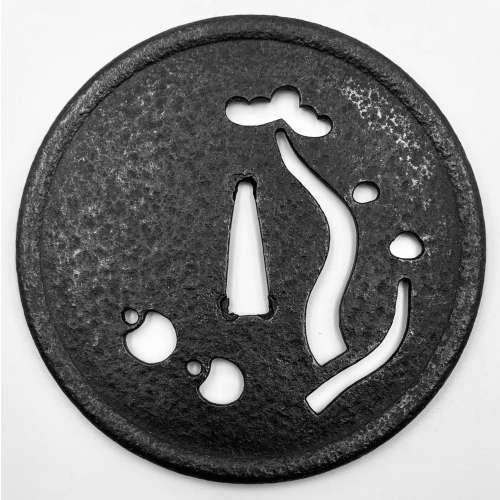
Iron tsuba of circular form with design of pine trees (matsu) and monkey toys (kukurizaru) in openwork (ko-sukashi). Ko-Katchushi school.
Raised rim (mimi) with iron bones (tekkotsu). Size: Diameter: 99.5 mm; Thickness: 2.1 mm at centre; 4.3 mm at the rim.Early Muromachi period: 15th century (Kakitsu - Bun'an era, 1441 - 1449).
-

Iron tsuba of round form pierced (sukashi) and inlaid in flat (hira-zōgan) and cast brass (suemon-zōgan), details carved in kebori, with design of two phoenixes, bamboo, and paulownia leaves and flowers (kiri-mon) on both sides. According to seller: Bizen-Yoshirō school (or Heianjō school). Unsigned.
Momoyama period. End of the 16th - beginning of the 17th century. Dimensions: Diameter: 99.5 mm; Thickness: 2.1 mm at centre; 4.3 mm at the rim. According to Merrily Baird (Symbols of Japan), "bamboo teamed with paulownia blossoms or with paulownia and the phoenix, in reference to the Chinese legend that the phoenix perches only on the paulownia and eats only the bamboo". Citation from http://www.clevelandart.org/art/1986.2.1: "The immense heraldic birds on display [...] reflect the Momoyama era's spirit of newly gained self-confidence and an affinity for grand expressive statements in painting, architecture, the textile and ceramic arts, as well as garden design. While that period preceded the arrival of prosperity, it clearly marked an extraordinary moment in Japanese cultural history, one frequently compared with the twelfth century of the Heian period. [...] Rather than an emblem of immortality, as it is in Western lore, in Japan, the phoenix evolved out of its origins in Chinese mythology to become, by the sixteenth century, an auspicious symbol of political authority. Together with clusters of the distinctively shaped paulownia leaves, this long-tailed, mythical bird [...] proclaiming an air of graceful command". -
 Iron tsuba of six-lobed (mutsu-mokkō-gata) form, with six wild boar's eye shape (inome) openings (sukashi). Ryo-Hitsu and the entire perimeter of tsuba have typical for this school raised rim; raised seppa dai. Lobes are decorated in low relief carving (sukidashi-bori). On the obverse: chrysanthemum, Genji mon, waves and rocks, grasses and star, bellflower, star and flower in tortoiseshell (kikko). On the reverse: Stars and different flowers, and flying geese. The plate is damaged to the left of nakago-ana and around the left hitsu-ana. Kamakura-bori school. Late Muromachi period (1514-1573). Diameter: 89 mm; Thickness at seppa-dai: 4.0 mm; Weight: 108.8 g [large]. There is a similar tsuba in this collection, TSU-0345.2018, but with a different motif and much smaller: diameter 74.3 mm, thickness at seppa-dai: 3.2 mm, weight: 62.8 g.Another look-a-like tsuba can be found at the Compton Collection, part II, pp. 14-15, №17, though his tsuba is more massive (80 x 84 x 4 mm).
Iron tsuba of six-lobed (mutsu-mokkō-gata) form, with six wild boar's eye shape (inome) openings (sukashi). Ryo-Hitsu and the entire perimeter of tsuba have typical for this school raised rim; raised seppa dai. Lobes are decorated in low relief carving (sukidashi-bori). On the obverse: chrysanthemum, Genji mon, waves and rocks, grasses and star, bellflower, star and flower in tortoiseshell (kikko). On the reverse: Stars and different flowers, and flying geese. The plate is damaged to the left of nakago-ana and around the left hitsu-ana. Kamakura-bori school. Late Muromachi period (1514-1573). Diameter: 89 mm; Thickness at seppa-dai: 4.0 mm; Weight: 108.8 g [large]. There is a similar tsuba in this collection, TSU-0345.2018, but with a different motif and much smaller: diameter 74.3 mm, thickness at seppa-dai: 3.2 mm, weight: 62.8 g.Another look-a-like tsuba can be found at the Compton Collection, part II, pp. 14-15, №17, though his tsuba is more massive (80 x 84 x 4 mm).
Varshavsky Collection: TSU-0345.2018
This tsuba, TSU-0401.2019, is the biggest of all three (another mine and the one from Campton Collection). The presence of a flower in a tortoiseshell symbol (crest or mon) on this tsuba alludes to Izumo Shrine. The overall piece, with symbols of grasses, waves, flowers, incense, stars, and flying geese, is full of autumnal connotations.
Compton Collection, part II, pp. 14-15, №17: Kamakura-bori tsuba, ca. 1450.
-
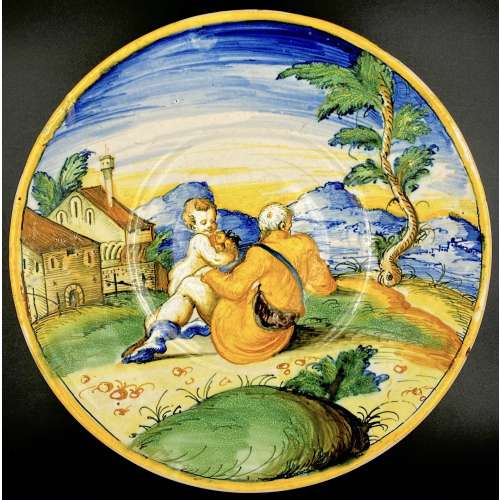
-
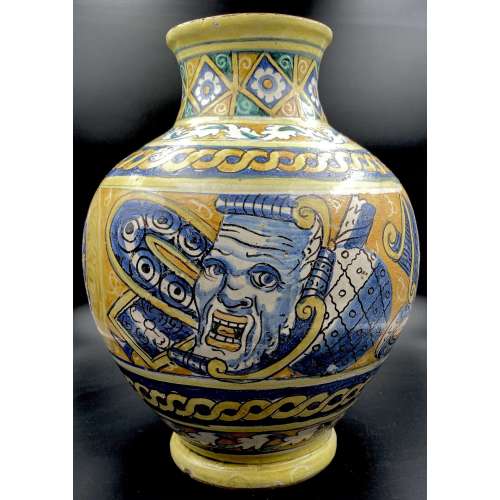
-
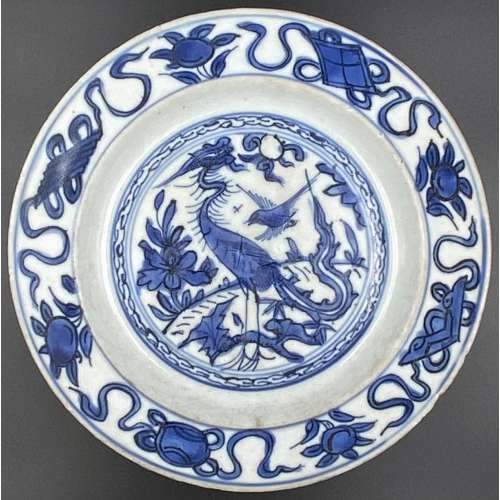 Plate with crane, bird, plants, and four treasures. Porcelain with underglaze blue decoration and illegible factory mark to the bottom. Ming Dynasty [大明] (1368 – 1644); Wanli Era (1572 – 1620); Late 16th – Early 17th century. Diameter: 19.5 cm; Height: 3 cm
Plate with crane, bird, plants, and four treasures. Porcelain with underglaze blue decoration and illegible factory mark to the bottom. Ming Dynasty [大明] (1368 – 1644); Wanli Era (1572 – 1620); Late 16th – Early 17th century. Diameter: 19.5 cm; Height: 3 cm -
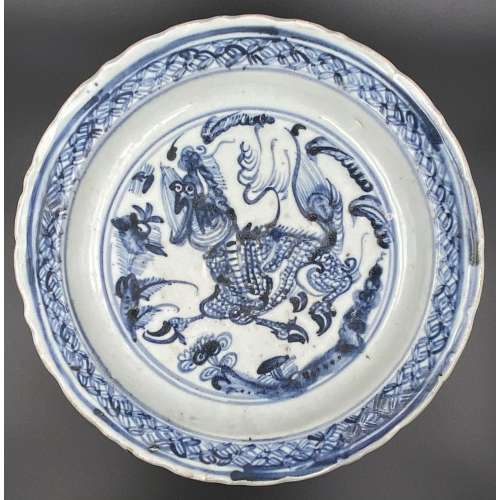 Footed plate with scalloped rim, centre decorated with running yak or another even-toed animal among flowers, jewel diaper pattern to the inner lip; foliage motif to the outside is bordered with foliage above and lotus leaves below. Porcelain with underglaze blue decoration. Ming Dynasty [大明] (1368 – 1644); Wanli Era (1572 – 1620); Late 16th – Early 17th century. Diameter: 25.5 cm; Height: 4.2 cm
Footed plate with scalloped rim, centre decorated with running yak or another even-toed animal among flowers, jewel diaper pattern to the inner lip; foliage motif to the outside is bordered with foliage above and lotus leaves below. Porcelain with underglaze blue decoration. Ming Dynasty [大明] (1368 – 1644); Wanli Era (1572 – 1620); Late 16th – Early 17th century. Diameter: 25.5 cm; Height: 4.2 cm -
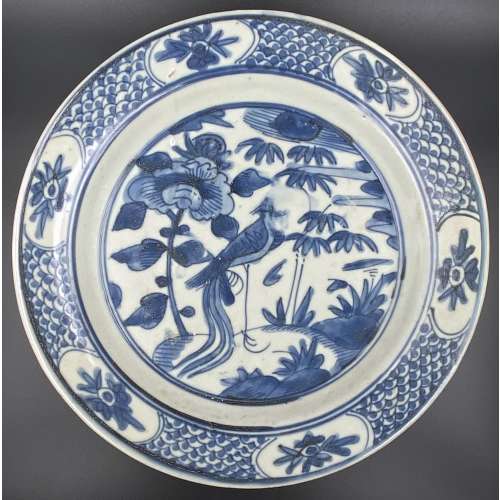 Underglaze cobalt blue and white Zhangzhou (Swatow) porcelain plate decorated vigorously and spontaneously with a bird in the landscape, and flowers in oval cartouches among waves or fish scale diaper. Sand particles on the base. Ming Dynasty [大明] (1368 – 1644); Wanli Era (1572 – 1620); Late 16th – Early 17th century. Diameter: 28.2 cm; Height: 4.0 cm
Underglaze cobalt blue and white Zhangzhou (Swatow) porcelain plate decorated vigorously and spontaneously with a bird in the landscape, and flowers in oval cartouches among waves or fish scale diaper. Sand particles on the base. Ming Dynasty [大明] (1368 – 1644); Wanli Era (1572 – 1620); Late 16th – Early 17th century. Diameter: 28.2 cm; Height: 4.0 cm -
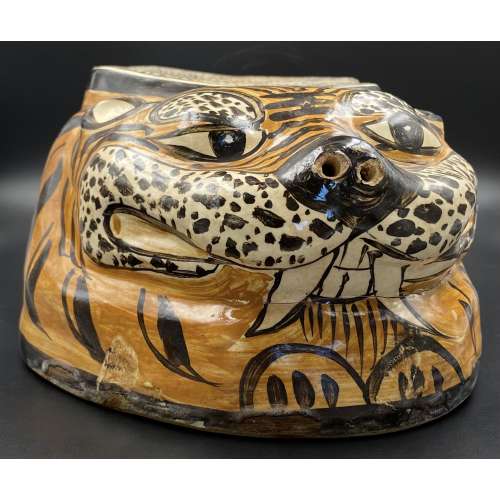 The pillow is moulded as a recumbent tiger, the details painted in dark brown and pale russet on a white slip and under a clear glaze, and the slightly dished top is painted with a winged beast. China, the Jin dynasty [金朝] (1115 – 1234). Dimensions: 12 x 34.5 x 19.5 cm
The pillow is moulded as a recumbent tiger, the details painted in dark brown and pale russet on a white slip and under a clear glaze, and the slightly dished top is painted with a winged beast. China, the Jin dynasty [金朝] (1115 – 1234). Dimensions: 12 x 34.5 x 19.5 cm -
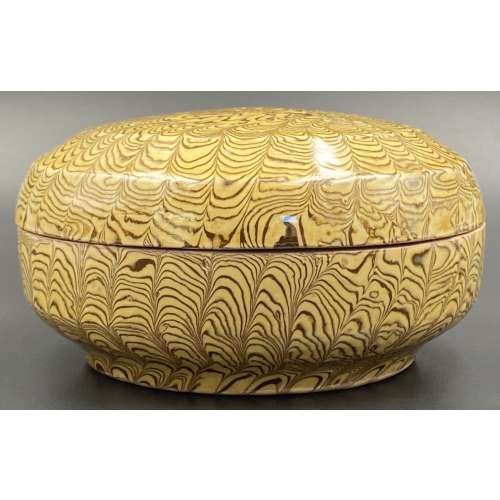 Press moulded round box with a cover made of yellow and brown marble clay, glazed with a clear glaze inside and outside. China, the Tang dynasty [唐朝] (618 – 907) Diameter: 11 cm; Height: 5.5 cm.
Press moulded round box with a cover made of yellow and brown marble clay, glazed with a clear glaze inside and outside. China, the Tang dynasty [唐朝] (618 – 907) Diameter: 11 cm; Height: 5.5 cm. -
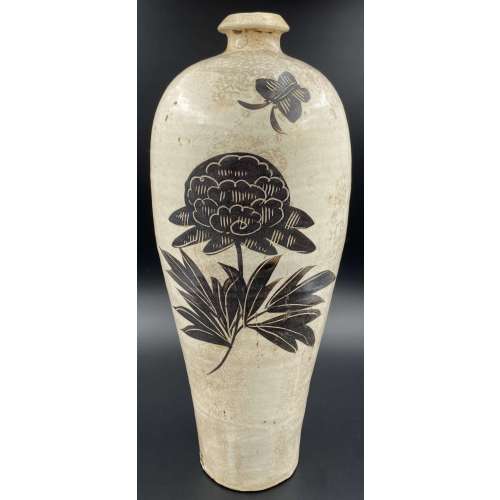 Typical meiping body, short neck, lipped rim; painted in the blackish-brown slip with two blossoms and butterflies under a clear glaze. The foot ring is unglazed exposing the brown body. China, the Yuan Dynasty [大元] (1279 – 1368). Diameter: 14 cm; Height: 30.5 cm.
Typical meiping body, short neck, lipped rim; painted in the blackish-brown slip with two blossoms and butterflies under a clear glaze. The foot ring is unglazed exposing the brown body. China, the Yuan Dynasty [大元] (1279 – 1368). Diameter: 14 cm; Height: 30.5 cm. -
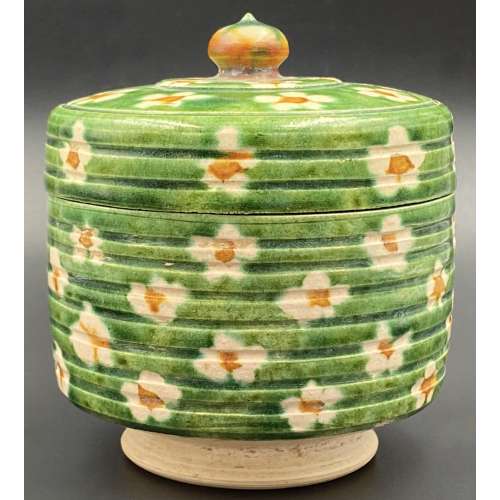 Green, mottled (white, yellow, brown) glazed earthenware jar or a circular box with a cover, on an unglazed foot decorated with florets. The cover has a small knop. Ivory glaze inside. China, the Tang dynasty [唐朝] (618 – 907). Diameter: 10 cm; Height: 10 cm.
Green, mottled (white, yellow, brown) glazed earthenware jar or a circular box with a cover, on an unglazed foot decorated with florets. The cover has a small knop. Ivory glaze inside. China, the Tang dynasty [唐朝] (618 – 907). Diameter: 10 cm; Height: 10 cm. -
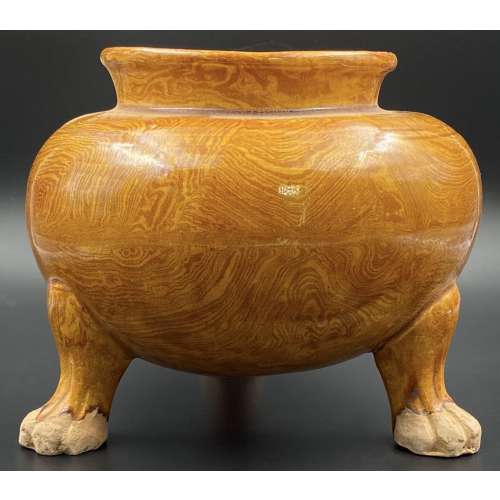 Amber-glazed marbled pottery tripod censer, standing on unglazed beast's paws. The clay itself is not marbled, only the glaze. China, the Tang dynasty [唐朝] (618 – 907). Diameter: 16 cm; Height: 14 cm.
Amber-glazed marbled pottery tripod censer, standing on unglazed beast's paws. The clay itself is not marbled, only the glaze. China, the Tang dynasty [唐朝] (618 – 907). Diameter: 16 cm; Height: 14 cm. -
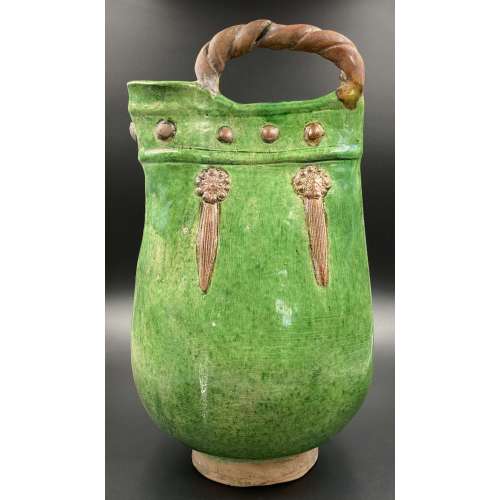 Footed purse-like ewer with twisted handle, with sculptured body glazed in green and details glazed in brown, on an unglazed foot. China, the Liao Dynasty [辽朝] (907 – 1125). Dimensions: 29 x 15 x 15 cm
Footed purse-like ewer with twisted handle, with sculptured body glazed in green and details glazed in brown, on an unglazed foot. China, the Liao Dynasty [辽朝] (907 – 1125). Dimensions: 29 x 15 x 15 cm -
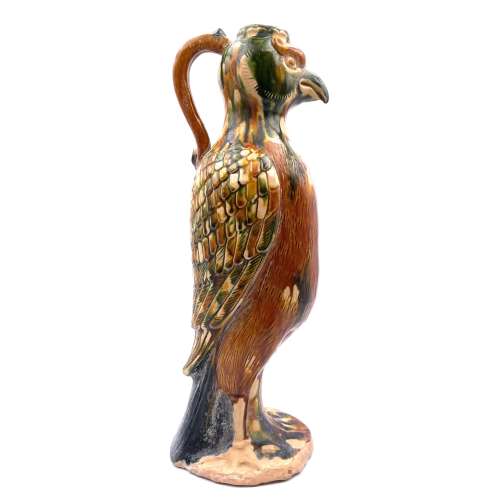 Made of two moulded symmetrical halves, joined before attaching the handle. On an unglazed base. Glazed in three colours (green, amber and ivory) and the tail is glazed black or dark blue. China, the Tang dynasty [唐朝] (618 – 907). Height: 37 cm.
Made of two moulded symmetrical halves, joined before attaching the handle. On an unglazed base. Glazed in three colours (green, amber and ivory) and the tail is glazed black or dark blue. China, the Tang dynasty [唐朝] (618 – 907). Height: 37 cm. -
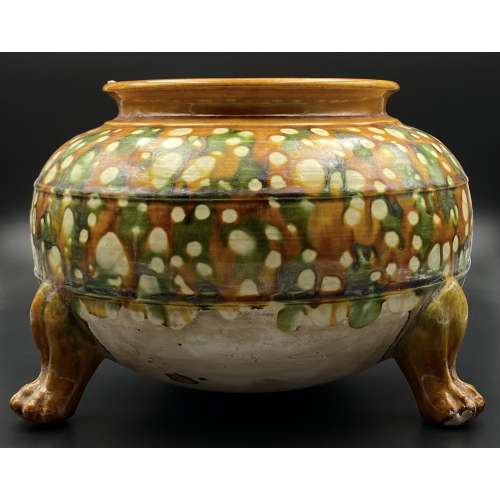 A tripod earthenware jar with the upper half decorated with three-colour glaze in brown, green, and white, and the bottom half unglazed; spur marks to the mouth. Henan kiln. China, the Tang dynasty [唐朝] (618 – 907). Diameter: 22 cm; Height: 15.5 cm
A tripod earthenware jar with the upper half decorated with three-colour glaze in brown, green, and white, and the bottom half unglazed; spur marks to the mouth. Henan kiln. China, the Tang dynasty [唐朝] (618 – 907). Diameter: 22 cm; Height: 15.5 cm


